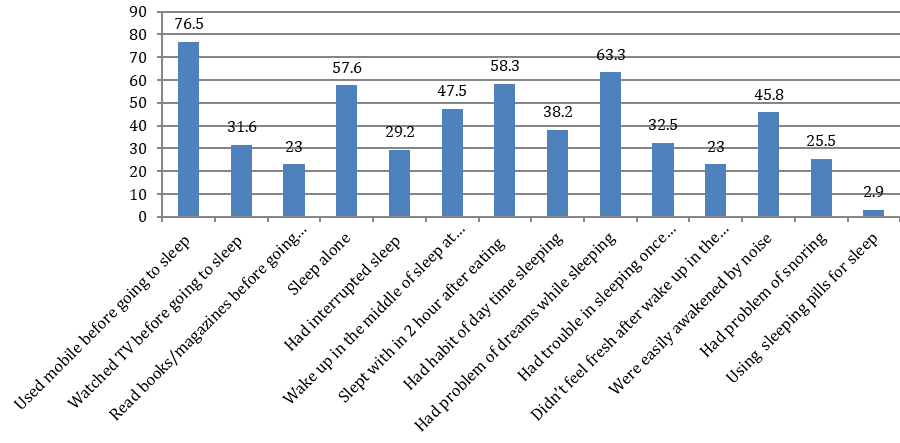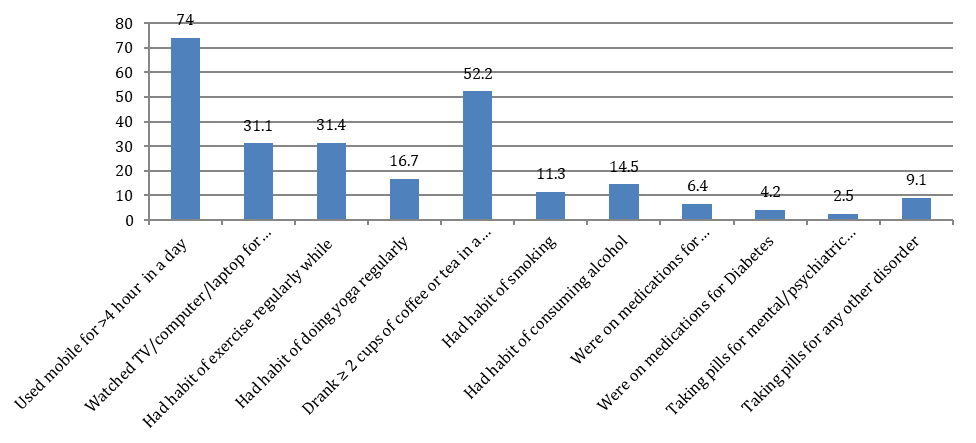There have been reports of poor sleep patterns & sleep habits among adults in Shimla city. Therefore, this study was planned to evaluate the sleep pattern and sleep habits among adult population in Shimla city.
The introduction of media in bedrooms such as television, video games, internet, and mobile phones were largely held responsible for sleep debt. In the present study, 94 (23%) participants read books or magazines before going to sleep in bed while 314 (77%) participants reported that they did not read books or magazines before going to sleep in bed.
Regarding the use of mobile, 312 (76.5%) participants reported that they use mobile for chatting on social media/ playing games/watching movie before going to sleep in bed. Whereas, 129 (31.6%) participants stay awaked late at night and watched TV before going to sleep in bed. In contrast to our findings, in the study done by Giri et al. [7] 52% participants were using mobile for chatting on social media/playing movie before going to sleep in bed. Also, in the study done by Peter et al. [8], 42.8% participants were using mobile for chatting on social media/playing games/watching movie before going to sleep in bed.
Out of 408 participants, 128 (31.4%) participants have habit of exercise regularly whereas 280 (68.6%) of the participants did not reported for doing exercise regularly. Similarly, 68 (16.7%) participants have habit of doing yoga regularly. Similar to our findings, in the study done by Giri et al. [7], 24% participants reported physical active.
In contrast to our study, majority of students (67.0%) reported being physically active in the study done by Lemma et al. [9]. This difference may be due to the fact that in our study we had taken population of all age group while in the study done Lemma et al. [9] only college students were included.
Out of 408 participants, 221 (54.2%) participants were not easily awakened by noise, while 187 (45.8%) participants were easily awakened by noise. Whereas, 304 (74.5%) participants reported that they did not have problem of snoring, while 104 (25.5%) participants have problem of snoring. There are many factors influencing our sleep and sleep quality. The room temperature may not be ideal, a person may be suffering from common cold, a partner, children or pets could be disturbing the sleep, the environment can be too noise. Sometimes the reason behind a bad night of sleep is an actual medical condition or a sleep disorder.
Out of 408 participants, majority of the participants i.e., 31 (7.6%) use mobile for >4 hour in a dayand 205 (50.2%) of the participants use TV/computer/laptop for <1 hour in day followed by 76 (18.6%) participants who use TV/computer/laptop for 1-2 hours in a day whereas 38 (9.3%) participants use TV/computer/laptop for 2-3 hours in a day, 35 (8.6%) participants for 3-4 hours in a day and 54 (13.2%) participants use TV/computer/laptop for >4 hours in a day.
In contrast to our findings, Murugesan et al. [10]. Reported that majority of adolescents64.1%, (345) watched TV in bed and about 23% (125) used their mobile phone in bed .In another study by Apurva Mishra et al. [11], participants using media after 8 pm and sleeping alone were in significant sleep debt. Screen activities such as TV, internet and cellular phones in the bedroom had a negative effect on children’s sleep/wake patterns and duration of sleep.
In this study, 235 (57.6%) participant sleep alone whereas 173 (42.4%) participants sleep with family member and 289 (70.8%) participants stated that they did not have interrupted sleep. Similarly, majority of participant i.e., 214 (525%) did not wake up in the middle of sleep at night followed by 99 (24.3%) participant who wake up one time in the middle of sleep at night.
Similar to our finding,the study done by Giri et al. [7] more participants were sleeping alone as compare to the participants who were sharing room with family members. Whereas, Murugesan et al. [10]. Reported nearly 80% (430) of adolescents slept along with family membersin the same room and about 76% (410) did not have a separate bedroom to sleep.
Among children bed sharing is studied to increase sleep anxiety and daytime sleepiness. Similar results are found when parents share their bed with a child. Co-sleeping with the child puts the parents into the risk for sleep deprivation and increased stress which furthermore can cause marital conflicts.
In this study , 107 (26.2%) participants have 30-60 min time gap between eating and sleeping which was less as compared to study conducted by Murugesan et al. [10]. where about half the respondents had a heavy meal at dinner time and >75% went to bed within 1 hour of having dinner. Inter group comparison shows that there was statistical significant difference between participants who have >120min time gap between eating and sleeping and those who have 30min-120min/zero tome gap (p = 0.0175)
An experimental study from Brazil showed that having dinner close to the bedtime and late-night snacking can lead to poor sleep quality and sleep interruptions. Adolescents who had greater time gap between dinner and sleep had better quality sleep as indicated by lesser daytime sleepiness.
In this study, 156 (38.2%) participants have habit of day time sleeping. Out of those, 88 (21.6%) participants sleep for 1 hour in day , 68 (16.7%) participants sleep for 1-2 hours in a day and 18 (4.4%) participants sleep for >2 hours in a day. Inter group comparison shows that there was statistical significant difference between the participants who have habit of day time sleeping and who did not have habit of day time sleeping (p = 0.000)
In contrast to our findings, in the study done by John [12] reported 52.1% participants have habit of day time sleeping and in the study done by Peter et al. [8] 20.9% participants have habit of day time sleepiness.
In this study, out of 408 participants, 150 (36.8%) participants reported that they did not have problem of dreams while sleeping whereas 258 (63.3%) participants had problem of dreams while sleeping. Similarly, when asked about trouble of sleeping, once awake, Only 145 (32.5%) participant reported that they had trouble in sleeping once awake. According to the level of freshness, majority of the participants i.e., 314 (77.0%) feel fresh after wake up in the morning. Similar to our findings, in the study done by Al-Wandi et al. [13]. 30.1% participants have difficulty in getting back to sleep once awake. In study conducted by Al-Wandi et al. [13]. Sleep problems, frequent arousals with difficulty getting back to sleep was the most encountered sleep problem among our sample and higher grades had a higher prevalence of this problem.
This study shows that 46 (11.3%) of the participants had habit of smoking while majority of the participants 362 (88.7%) were non-smokers. Similarly, 59 (14.5%) of the participants had habit of consuming alcohol.
Similar to our findings, in the study done by Lemma et al. [9] nearly a fifth (19.1%) of participants reported drinking at least one alcoholic beverage per month. In contrast to our findingsin the studydone by Giri et al. [7] 724% participants were alcohol consumer. This may be followed by depression, irritability, anorexia and difficulty in sleeping. Research has indicated smoking tobacco can lead to sleep fragmentation, decreased total sleep time and delayed sleep onset latency.
In this study, 12 (2.9%) participants use any sleeping pills for sleep, 26 (6.4%) participants were on medications for hypertension, 17 (4.2%) participants for diabetes, 10 (2.5%) participants take pills for mental/psychiatric disorder and 37 (9.1%) participants usually take pills for any other disorder. In contrast to our finding, the study done by Lemma et al. [9] reported that 8.5% participants were using sleeping pills and Berhanu et al. [14] reported that 23.7% participants were using sleeping pills.
The reported variations between different studies may be influenced by different socioeconomic demands and cultural habits among the different population groups.
Limitations
Sleep problems may be worse than those reported in our study, as individuals may give socially desirable answers such as not having sleep problems. Thus, this survey may be limited by under reporting. As this study was conducted with limited resources in only urban population of Shimla city of Himachal Pradesh, the results may not be applicable to rural population but it can only be generalized to urban adult population coming from similar socioeconomic conditions. So, the similar study may be conducted on large sample including rural adult population for wider generalization. Further multi-centric studies based on large sample size, longer period with separate data on weekdays and weekends are needed for wider generalization of study findings.



